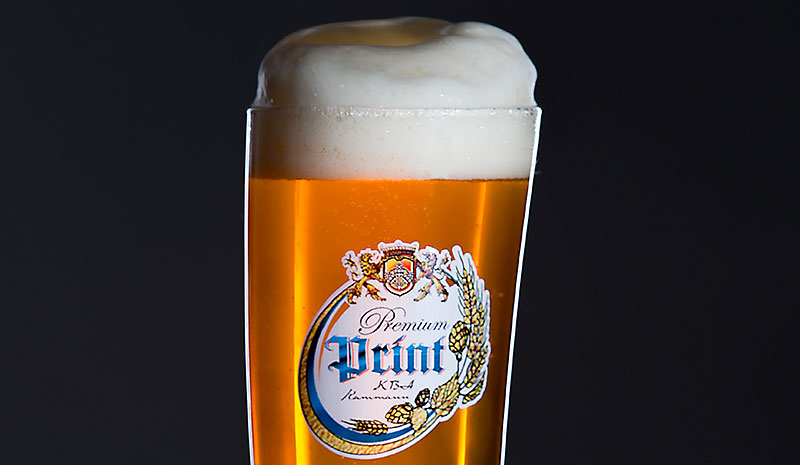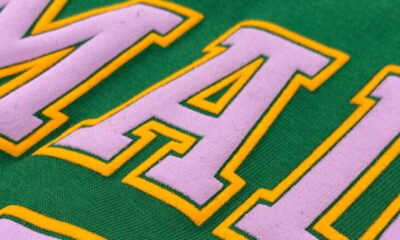Trends
Glass Action: Growth in the Glass Printing Sector
Both functional and decorative applications present sizeable opportunities for the glass industry.
Published
6 years agoon

GLASS DECORATION has been carried out for hundreds of years, with stained glass created by skilled artisans being the most ornate and expensive option. Hand painting and decoration was a lower-cost alternative, using enamel and special inorganic paints that required firing to provide durability.
Over time, glass has become an interesting area for the print industry. It’s used in many applications that range from residential and commercial decorative glass to industrial applications, each with distinct demands for the printing that is done. It may be flat sheet glass for architectural use; a hollow container glass – usually a tube sealed at one end to form a drinking vessel; a lightbulb/tube; laboratory glass; lenses; or an ornamental object, such as a vase. There are demands for things like weatherproof printed architectural glass and specialty applications like glass cooking surfaces. It’s a very wide field.
Advances in glass printing form part of the wider functional and industrial printing movement, defined by Smithers Pira research in “The Future of Functional and Industrial Printing to 2022”– which shows the print industry is growing into markets outside of conventional graphic arts printing, which remains largely on paper. Printing technology is widely used to decorate many objects, from architectural and automotive glass to ceramics and electronics, household items, toys, and textiles. It can be used with special inks to create new functions – including biomedical and photovoltaics, which are becoming significant markets. Some sectors are established – wallpaper printing, for example, dates back hundreds of years – while others are emerging with lots of hype, such as 3D printing and printed electronics.
Industrial printing takes place across the world. Routes to market vary widely, with large manufacturers employing printing functions in house (sometimes inline) as part of their processes, and specialist print businesses supplying components. Both functional and decorative applications present sizeable opportunities for the glass industry, as an increasing number of glass components and products integrate printing.
Printing Process Developments
Technology breakthroughs have played a big part in the growth of glass printing. Suppliers have developed new equipment that widens the applications, with new inks, coatings, and functional fluids providing advanced properties of flexibility, adhesion, and durability, together with novel capabilities in electronics and biomedical to perform specific actions. These developments were driven by, and also enabled, truly transformative innovations in everything from smartphones to solar cells.
While analog printing methods – gravure, flexo, litho, screen, pad printing, and foiling – are still widely used, there is very strong growth in digital methods, with new inkjet inks and fluids opening many opportunities.
AdvertisementGravure, screen, pad printing, and foiling are perfectly adequate for many of the long-established applications in which they are used. In producing a beer stein or sheet of exterior architectural glass, the printing is a small component of the process and often the decoration will be integrated in the manufacturing line. In a changeover, manipulating the print setup is generally a lot simpler than changing the product to be manufactured. The required skillset for this type of printing is probably less than in commercial print or packaging; prepress production is often outsourced with screens, plates, and cylinders brought in as required and reused over many years. The management of the industrial plant will concentrate on improving the methods of making the product rather than the intricacies of print technology. There is also much activity in developing routes to market, for print suppliers and equipment manufacturers as well as for the associated consumables.
Glass Printing Markets
Printing colorants (chiefly through screen printing technology) has, over time, become a lower-cost alternative for glass decoration. Interior architectural glass, mirrors, and gaming machines are printed using organic inks, both solvent and UV curable. Exterior and dishwasher-proof glass tends to use inorganic inks and enamels that contain pigments, glass frits, solvent-based binding agents, and additives. After printing, the ink is cured in a lehr at around 1110 F (for enamels) to fuse the printed layer to the glass surface for a permanent finish.

The overall demand for flat glass, produced by float techniques, is dependent on construction and rose 7.1 percent in 2015-2016 to 99 billion square feet, some 70-75 million tons. Asia is the biggest and fastest growing glass market, accounting for 60 percent of all flat glass by area – though obviously, much of this is unprinted. Fabricated flat glass demand will benefit from rapid growth in sales of energy efficient products, such as solar control, insulation, and low-emissivity (low-E) fixtures.
By 2022, glass printing is forecasted to reach a market value of around $1.3 billion and have a compound annual growth rate (CAGR) of seven percent from 2017-2022. Screen printing is widely used to print onto flat and hollow glass. Glass producer Pilkington sells screen-printed glass for use in partitions, roof glazing, and external walls, while there are many specialist decorators who print glass they source. Screen printing can lay down heavy deposits of colored inks and specialist coatings that provide dramatic decorative effects or simpler designs for privacy or solar control.
Glass is also the substrate used for many electronic devices, including displays, touch panels, and photovoltaic applications. The printing requirements for these glass products vary significantly, from architectural to automotive to domestic appliances, creating new equipment and process solutions. The majority of these technical glass products require multipass printing with high demands on the registration of the different ink layers, as well as a scratch-free transport during the printing process and very tight tolerances of the printed layer thickness, especially for large areas of functional printing layers.
AdvertisementLatest Glass Print Developments
In recent years, there have been many developments in systems and technology to advance the application of printing on glass. Earlier in 2018, the Spanish company Tecglass (part of the Fenzi Group) launched a line of multifunctional machines for digital printing on large sheets of glass, which are designed to deliver both single-pass and multipass print speeds with high resolution and multicolor print quality.

Tecglass’s F Type F K Series line makes it possible to print glass sheets up to 47.2 x 177.2 inches in a single pass, and larger sizes in multiple passes, in just a few seconds. This line is suitable for mass printing of frames, logos, patterns, and graphic motifs on all types of glass, most notably for the automotive and household appliance industries and interior design. The system can be upgraded to seven color channels, with up to 36 printheads in dual-color technology, or 72 single printheads at 1000 nozzles per color. A high flowrate ink-recirculation system means that heads don’t need to be cleaned, according to Tecglass, while the system’s Simultaneous Drying Technology offers automatic drying of the glass sheet concurrent with printing. The entire line was engineered to optimize and simplify printing operations for continuous cycle production, where it is essential to have a machine that combines high precision and efficiency.
Other firms have also developed digital print systems specifically for glass printing. For instance, KBA-Kammann and Machines Dubuit have been developing inkjet decoration systems for glass bottles and containers since 2014, driving packaging applications. Dip-Tech (sedak in Germany and Tianjin Northglass in China) supply inkjet glass printers for both external and internal architectural and automotive applications, together with suitable inks and curing units to provide fully integrated systems.
In 2017, Dip-Tech was acquired by the Ferro Group, as part of a strategy to expand the parent company’s glass printing business. In an official release on the acquisition, Dieter Binder, VP of Ferro’s Performance Colors and Glass business, and VP for Europe, comments: “The addition of Dip-Tech to Ferro expands our offering to the fast-growing digital glass printing segment. Together, we look forward to actively shaping change in the glass industry.”
Summary
In functional markets, like glass printing, established suppliers may be part of a wider manufacturing company or a specialist contract supplier. In Japan, traditional print companies have taken shares of the electronics and lifestyle print sectors, but this is not the case in the rest of the world.
AdvertisementThere are complex routes to market and supply chains across industrial and functional print segments. As the topic is featured more often in conferences and exhibitions, the routes to market are expanding. Users are looking for innovation and process efficiencies, providing many opportunities for print companies and for their suppliers. Greater coverage of the topics in the trade press and events is raising awareness of the established players, which might improve their print and decoration using new techniques from new suppliers.
As part of the wider functional and industrial print movement, glass printing is in good company. It’s not only an area with opportunities for market growth and promising signs of development: The broader technology and market advances of functional and industrial print will add momentum to this interesting sector of the print industry over the coming years.
For more information on Smithers Pira’s market report, “The Future of Functional and Industrial Printing to 2022,” see smitherspira.com/industry-market-reports or contact Sean Walsh at swalsh@smithers.com.

SPONSORED VIDEO
Let’s Talk About It
Creating a More Diverse and Inclusive Screen Printing Industry
LET’S TALK About It: Part 3 discusses how four screen printers have employed people with disabilities, why you should consider doing the same, the resources that are available, and more. Watch the live webinar, held August 16, moderated by Adrienne Palmer, editor-in-chief, Screen Printing magazine, with panelists Ali Banholzer, Amber Massey, Ryan Moor, and Jed Seifert. The multi-part series is hosted exclusively by ROQ.US and U.N.I.T.E Together. Let’s Talk About It: Part 1 focused on Black, female screen printers and can be watched here; Part 2 focused on the LGBTQ+ community and can be watched here.
You may like
Advertisement

Inkcups Announces New CEO and Leadership Restructure

Hope Harbor to Receive Donation from BlueCotton’s 2024 Mary Ruth King Award Recipient

Livin’ the High Life
SUBSCRIBE

Bulletins
Get the most important news and business ideas from Screen Printing magazine's news bulletin.
Advertisement
Latest Feeds
Advertisement
Most Popular
-

 Art, Ad, or Alchemy1 month ago
Art, Ad, or Alchemy1 month agoF&I Printing Is Everywhere!
-

 Case Studies1 month ago
Case Studies1 month agoHigh-Density Inks Help Specialty Printing Take Center Stage
-

 Andy MacDougall1 month ago
Andy MacDougall1 month agoFunctional and Industrial Printing is EVERYWHERE!
-

 Columns2 weeks ago
Columns2 weeks ago8 Marketing Mistakes Not to Make When Promoting Your Screen Printing Services Online
-

 Editor's Note2 weeks ago
Editor's Note2 weeks agoLivin’ the High Life
-

 Thomas Trimingham2 months ago
Thomas Trimingham2 months ago“Magic” Marketing for Screen Printing Shops
-

 Marshall Atkinson2 weeks ago
Marshall Atkinson2 weeks agoHow to Create a Winning Culture in Your Screen-Printing Business
-

 News & Trends1 month ago
News & Trends1 month agoWhat Are ZALPHAS and How Can You Serve Them in Your Print Business?













